► EnduroKa 2020 explained
► Ben Barry grabs a seat for CAR
► Cheap motorsport at its best
CAR entered the EnduroKa championship this year. It’s a MSVR budget race series with a grid full of first-generation Ford Kas and a calendar of mostly long-distance races that you split with teammates. Here’s what we learned…
You can race on a budget
To race in EnduroKa, first you’ll need a 2002-2008 Ford Ka fitted with the 1.3-litre Duratec engine (59bhp or 69bhp). There are loads for under £1000, though you can spend much less – a top-three finisher at last year’s Oulton Park race cost £75. All the cars are fitted with the same upgrades, which include 13–inch alloys with Toyo Proxes tyres (changing for next year), a bolt-in rollcage, uprated shocks, springs and bushings, and uprated front brake pads. All the Ka-specific parts can be bought from recommended suppliers for under £3000, though you’ll also need a race seat, harnesses, extinguishers, cut-offs and rear rain light. It’s possible to buy and DIY prep a car for £4-5k. Entry fees vary race-to-race, but it was £925 for Oulton Park, £1250 for the IndyKa 500 at Brands – you split that with teammates, and there’s a lot of track time. Visit enduroka.co.uk for full details.
A Ford Ka isn’t as easy to race as you think
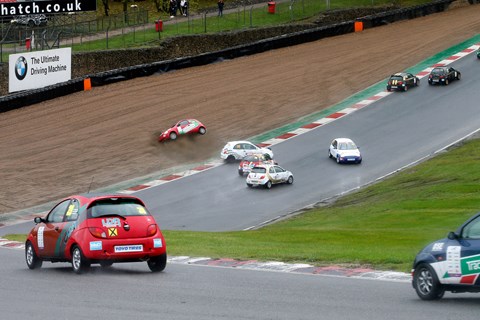
Yes, a Ka is slow, but there’s a lot more finesse to driving them quickly than simply keeping the throttle pinned everywhere. They pitch forwards under hard braking and loosen the rear end, and ABS (optional on some eligible Kas) is banned. It’s easy to push too hard and get scrappy with lock-ups and lift-off oversteer, so getting a competitive lap time out of them is a lesson in smoothness, car control and maintaining momentum. There are also plenty of times when it feels like a load of commitment to hustle this underpowered shopping car – Island bend at Oulton Park is a long left-hander that’s flat despite what your brain’s screaming at your ankle, and Paddock Hill Bend at Brands Hatch still feels like a leap of faith.
You learn a lot about racing
EnduroKa isn’t just about learning to drive a Ford Ka, it’s a very solid grounding in racing full stop. The fact that you can brake later when going uphill won’t be news to you, but EnduroKa made me analyse tracks much more deeply – precisely identifying braking points with visual cues, thinking about changes in tarmac and camber, even thinking about whether one side of the track was slightly more inclined than the other.
Everyone is in equal machinery, and while there are novices here, there are some very experienced racers: I shared the LDR Performance Tuning garage with Tim Harvey, for instance, and my teammate was up-and-coming racer Ben O’Hare, a seriously rapid youngster with a background in Ginettas and Mazda MX-5s. Following faster people around the circuit is as good as a lesson, and because they’re in near-identical machinery to you, they’re simply going faster because they’re doing it better.
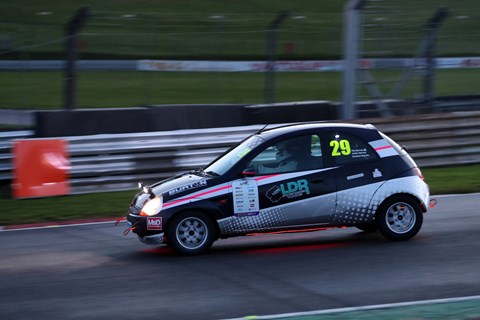
With so many evenly matched Kas packed on track, it’s also a lesson in racecraft – learning to follow and overtake and try to avoid trouble when it presents itself. Not to mention driving in the wet and dark as I did at the IndyKa 500 – I’ve never learnt so much driving a car for two hours.
People work hard at this stuff
Even at this level, I was blown away by the dedication and professionalism of the teams, drivers and marshals. People put their heart and soul into this passion, with many preparing their own cars while working full-time jobs, and giving up entire weekends to race and test. There are arrive-and-drive options, as we did, but it’s still a commitment. Special mention to the team that ran us, LDR Performance Tuning – the boss Lawrence works a full-time job away from motorsport as well as doing EnduroKa and the seriously high-level Mini Challenge. I watched his crew change an engine during a race, and replace a brake line in rapid time when I pitted with an unresponsive pedal. It’s all reinforced my respect for everyone who takes part in motorsport.
It’s a fun and friendly atmosphere
With races like the 12 Heures du Norfolk and IndyKa 500, clearly this is a series that’s focussed on fun. Car liveries reflect this too – I particularly liked the Silk Ka livery and the riff on the Pink Pig, a Porsche 917 with labelled with cuts of meat. Presumably the IP Racing team watched the Simpsons?
When cars got smashed at the highly eventful IndyKa 500 in bad conditions during qualifying, other teams lent a hand to get cars back out on track for the race. Oh, and I’ve never seen the ‘w’ word on a pitboard before or a car return to the pits with dance music blaring on the stereo.
The IndyKa 500 is the jewel in the crown
We raced at Snetterton, Oulton Park and Brands Hatch (twice), with Snetterton probably the weakest link due to its long straights and lack of elevation changes, which didn’t flatter the Ka. But the Kas really clicked at the more flowing Oulton and Brands. The best was saved until last with the IndyKa 500 season finale, with 500 minutes of racing on the Indy circuit, going into darkness as the winter nights set in, in late October. We raced and qualified in some seriously tricky conditions (the track was redflagged before all 47 entries left the pitlane in qualifying, when cars went off immediately), experienced racing in the dark in the rain for the first time and against a very competitive field.
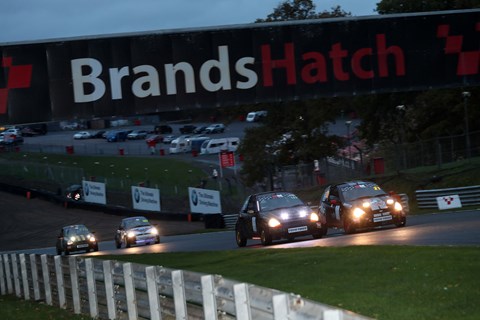
I was with four teammates, and ultimately our challenge fell apart with brake failure on my car (it felt like I’d locked up at Druids, but the brake line was actually leaking), a puncture, a steering issue and a little time in the gravel for me (another car was on its roof at Paddock Hill in the wet, I braked hard and oversteered into gravel – thanks marshals for the help!), but my laptimes seemed to get more competitive the worse the conditions (top 10 at times) and that was a real confidence boost. Ultimately we finished 35th of 47 starters (and 42 finishers) and some 24 laps down after the trouble, but I can genuinely say I was happy to simply take part and soak it all up.
Fancy a crack at it? There’s a new calendar shaping up for 2021, albeit with all the usual Covid caveats. Go and have a gander at enduroka.co.uk. Pictures by Gary Hawkins.
Keep reading for our report on round one of the EnduroKa series…
EnduroKa: 12 Hours du Norfolk
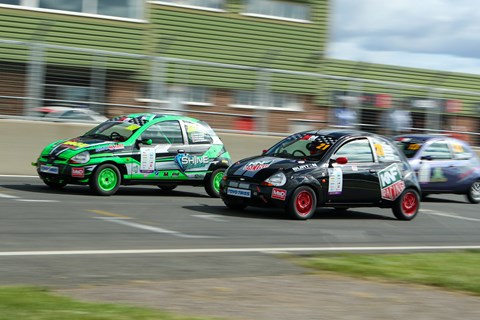
This summer might have been robbed of Le Mans, but the 12 Heures du Norfolk proved a fine substitute – it was part of the UK’s first post-lockdown race weekend and the first race in the rescheduled MSVR EnduroKa championship. I had a bash on behalf of CAR.
Relatively low-cost motorsport is thriving at the minute, and EnduroKa has big grids as it moves into its second season – around 40 Mk1 Kas lined up at Snetterton to race on the shorter 200 layout.
What exactly is EnduroKa?
All the cars/Kas are equal and run a control tyre, suspension, brake pads and roll-cage, and all the kit is sold by the same supplier. Races stretch from five hours to 12 hours, so there’s plenty of bang for your buck.
Some top-drawer drivers have done EnduroKa, including Le Mans winner Nick Tandy, and when I arrived at my garage I discovered my team LDR Performance Tuning were also running former BTCC and Carrera Cup ace Tim Harvey and his son.
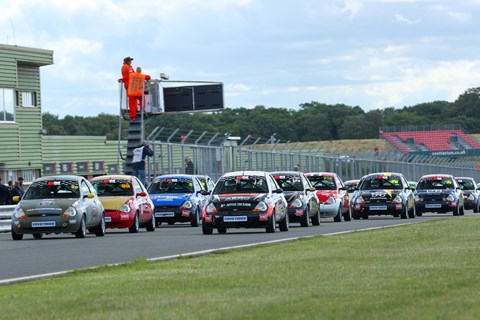
I’d be doing stints with three other drivers, each driver disinfecting the car afterwards, and we’d all get about ten minutes in qualifying – not ideal as it was the first time I’d drive the Ka, but no bother.
But driving a Ka is easy…
Yes, I know what you’re thinking – a Ka will be easy to drive because it’s so slow. And it is slow with its tiny little 1.3-litre engine, but it’s also quite loose on the rear and locks its front tyres very easily under braking (and often rears), partly because it moves around and lifts wheels up. So, when you thrash the life out of it down Snetterton’s start-finish straight and arrive at the fast first corner after a good run in fourth gear, it feels like a massive leap of faith to pitch this tiny little car in.
Loads of other cars certainly seemed to be going faster than me, but I started to build up to it over the few laps I had, finally reducing the lift to almost nothing on my final attempt. More than anything though, it’s keeping up smooth momentum in this low-grip, low-power car that’s key to a fast lap and it’s so easy to be scrappy and overdrive. I certainly didn’t feel like I’d cracked it in a handful of laps.
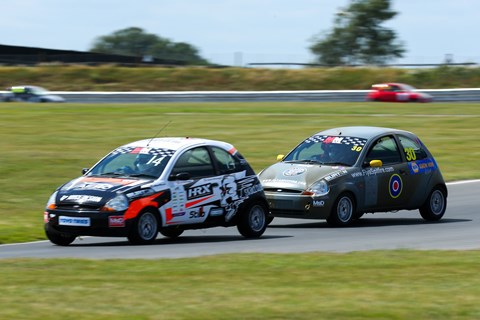
We ended up mid-grid thanks to the effort of my teammate Ben Hancy who’s previously raced MX-5s.
Race day!
I arrived back at the circuit the next morning ready for him to take the start at 9.10am. It was a rolling start and absolutely hilarious to watch a massive pack of Kas going past the pits at a very modest lick making almost no noise, almost like watching cars drive down the motorway.
I’d be going in last of the four drivers, so I sat and watched at the side of the track – and quickly realised that if these things look slow on a straight, they’re mad in the corners, all screeches of rubber, wisps of locked tyres and lift-off oversteer as the drivers chuck them about. I watched a car roll on its roof bouncing over a sausage kerb, heard the screech and silence of cars tangling at the end of the pit straight and watched one car spin off over the grass and the other drivers skilfully avoid him when he re-joined backwards. The standard of driving seemed generally very high from what I could see and had briefly experienced in quali and even the slower drivers didn’t seem like liabilities.
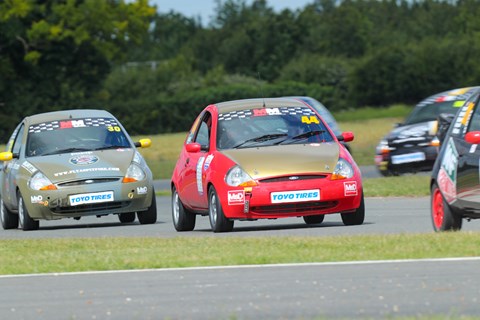
A few people told me the first corner was flat but I had my doubts; I liked the little throttle-lift that got it turned in, and then Tim Harvey gave me a bit of a pep talk. ‘Don’t take it flat,’ he said, ‘give it a quick lift, it’ll get the car rotated, won’t cost you any time and when you see the onboards of them taking it flat the tyres are screeching dreadfully. You need to settle yourself into a rhythm on an endurance race, don’t go pushing everywhere or you’ll just end up frazzled. It’s a long old stint.’ Properly calmed my nerves that did.
Sadly my opportunity never arrived because the Ka overheated just after its first stint (it was turned off incorrectly for the pitstop, cutting off the fan, cooking the engine). LDR and my fantastic pit crew boss Erin did a great job swapping in a new engine, but that had its own issues and so the car was retired after just a couple more laps.
I wish I’d been able to get a bit more settled in the Ka, but that’s how endurance racing goes sometimes, and the plan is to get back out with LDR at Oulton Park.
Ka-n’t wait. Sorry.
Check out more CAR culture features here